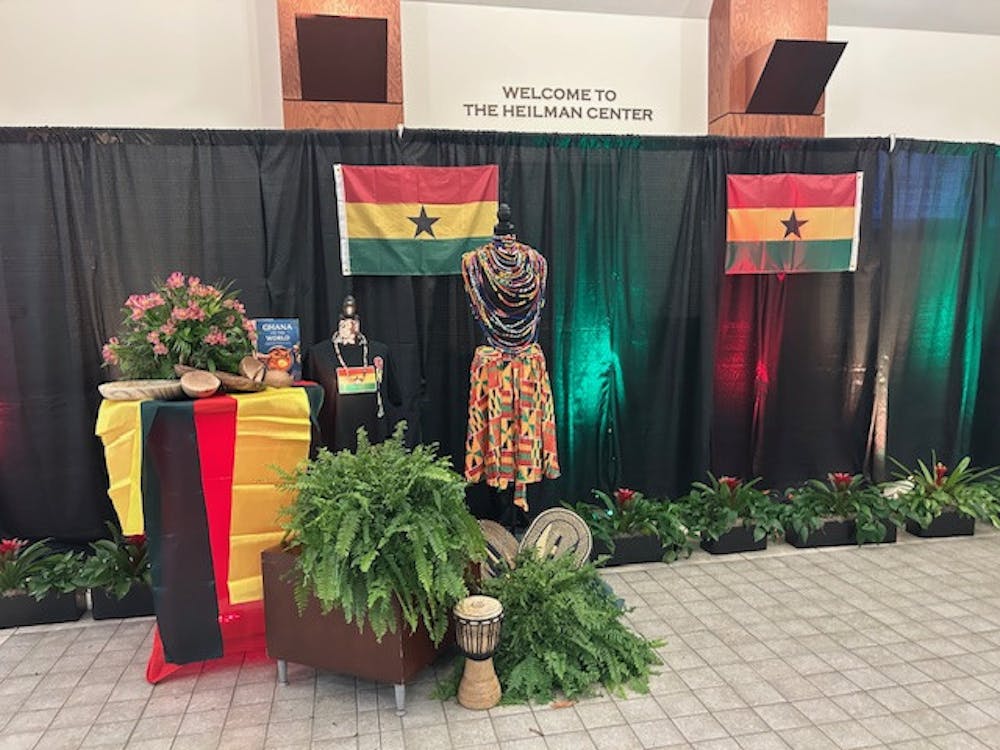Senior Caroline Cobert is the curator of the exhibition "Ti-Ameny-Net: An Ancient Mummy, An Egyptian Woman and Modern Science," which opens Thursday in the Lora Robins Gallery of Design from Nature. The exhibition displays Cobert's scientific study of the mummy, the mummy's coffin and Egyptian artifacts from the Stuart L. Wheeler Gallery of the Ancient World collection.
When Cobert was in her first year at Richmond, she read an article in The Collegian about the 2,700-year-old mummy, Ti-Ameny-Net, Wheeler Gallery in North Court.
Cobert, a biology and classical civilization double major, said she had thought the article had implied there were many unknowns about the mummy, and she had wanted to learn more. At the time, Cobert had wanted to start research in a faculty laboratory, but she had not found one that matched her interests yet.
Cobert said she had approached Elizabeth Baughan, assistant professor of classics and archaeology, and asked whether there was a way she could combine her two interests in classical civilization and biology by researching Richmond's mummy.
Baughan said it had been fortunate that Cobert had thought of the research topic her freshman year, because it gave Baughan and Cobert enough time to plan out her four years.
Baughan said Cobert had a love of ancient Egypt and mummies, and it was a matter of being in the right place at the right time, especially when Egyptologist Bob Briar visited Richmond in the spring of Cobert's first year. Baughan said Briar had provided Cobert with valuable insight into the research Cobert wanted to do on Ti-Ameny-Net.
Cobert used X-rays, CT scans and DNA extraction to learn more about the mummy, she said. The most recent X-ray of Ti-Ameny-Net had been taken in 1976, and the last CT scan had been taken in the 1980s, Cobert said. Cobert was able to use state-of-the-art technology at Virginia Commonwealth University to do the X-rays, CT scan and DNA extraction, she said.
After looking at data from the DNA extraction, Cobert was able to confirm that Ti-Ameny-Net had not died of tuberculosis or malaria. Cobert did not find any physical evidence of poor health from the X-rays or CT scans, she said. Cobert said that whatever had killed Ti-Ameny-Net must have been a disease that had acted quickly, because there was no trace of any disease in her body. The scientific data also helped Cobert determine that Ti-Ameny-Net was between the ages of 30 and 35 when she died.
Cobert used her background in classical civilization and ancient Egypt to study the coffin and preservation of the mummy. Cobert learned that Ti-Ameny-Net was wealthy, had a family that cared about her preservation and was most likely well taken care of in life and death, she said.
Cobert said the most challenging part of her research had been that no one was an expert on the subject, because DNA extraction from mummies has only been possible in the past five years. Cobert's research marked the first time that DNA extraction from a mummy occurred at VCU, Cobert said.
Between researching DNA extraction, ancient Egypt and how to curate an exhibit, Cobert had to combine the expertise of several faculty members in different fields to complete her research, Baughan said.
Elizabeth Schlatter, deputy director and curator of exhibitions, said she had taught Cobert how to curate an exhibit.
Enjoy what you're reading?
Signup for our newsletter
Schlatter said Cobert had proposed the exhibit last spring, and they had planned it this past fall. Schlatter said that most students who had put on exhibitions at the gallery had been art history majors. Cobert was the first student with a background in biology and classical civilization to curate an exhibition at the gallery.
Schlatter said Cobert's work was a great opportunity to show off student research and to demonstrate the resources that were available for undergraduate research at Richmond.
Baughan said she had hoped the exhibit would teach people that mummies were not just a curiosity to gawk at, but were humans who deserved to be respected and who had educational value.
"It's a new era in the university's stewardship of Ti-Ameny-Net," Baughan said.
Baughan said that Ti-Ameny-Net had not always been treated with the utmost respect throughout her years. There is evidence in the 18th century that Ti-Ameny-Net was the subject of a mummy unwrapping party where her arms were uncovered by people searching for valuable jewelry, she said. Ti-Ameny-Net was on display in 1876 at the downtown Richmond College campus, but when the campus moved to the West End, Ti-Ameny-Net was pushed into the back of biology classes and the library, put on display only for Halloween, until the Ancient New World Gallery put her on proper display in 1980, she said.
Shlatter said she felt a responsibility to respect the mummy's privacy as the caretaker of a human body. Ti-Ameny-Net is placed toward the back of the exhibit, behind a wall, for privacy purposes, Schlatter said.
Baughan said Egyptians believed that the number of times a person's name was written on his or her coffin indicated how long his or her after-life would be.
"We keep saying her name," Baughan said. By talking about Ti-Ameny-Net, her after-life is prolonged, she said.
"Ti-Ameny-Net was a cool lady," Cobert said. "She was a person, too. A lot of time people forget that when they are looking at remains."
Contact staff writer Madeline Small madeline.small@richmond.edu
Support independent student media
You can make a tax-deductible donation by clicking the button below, which takes you to our secure PayPal account. The page is set up to receive contributions in whatever amount you designate. We look forward to using the money we raise to further our mission of providing honest and accurate information to students, faculty, staff, alumni and others in the general public.
Donate Now


